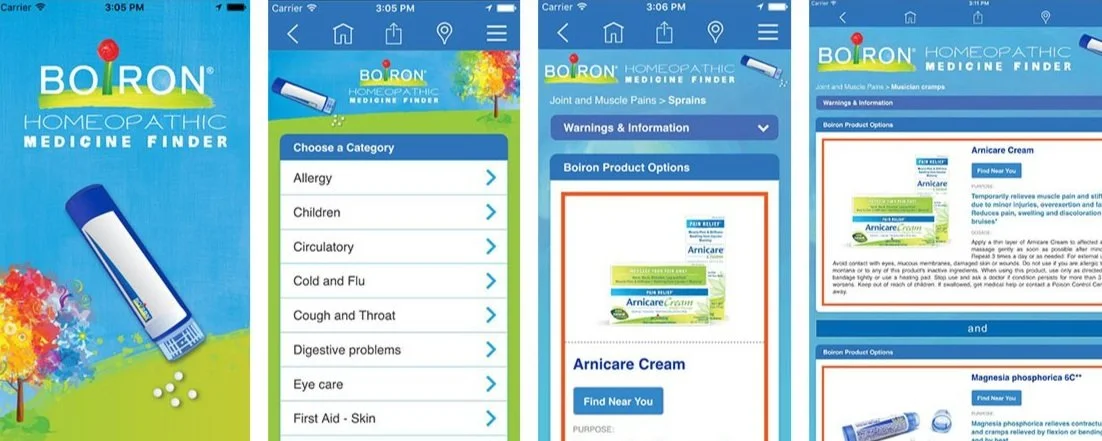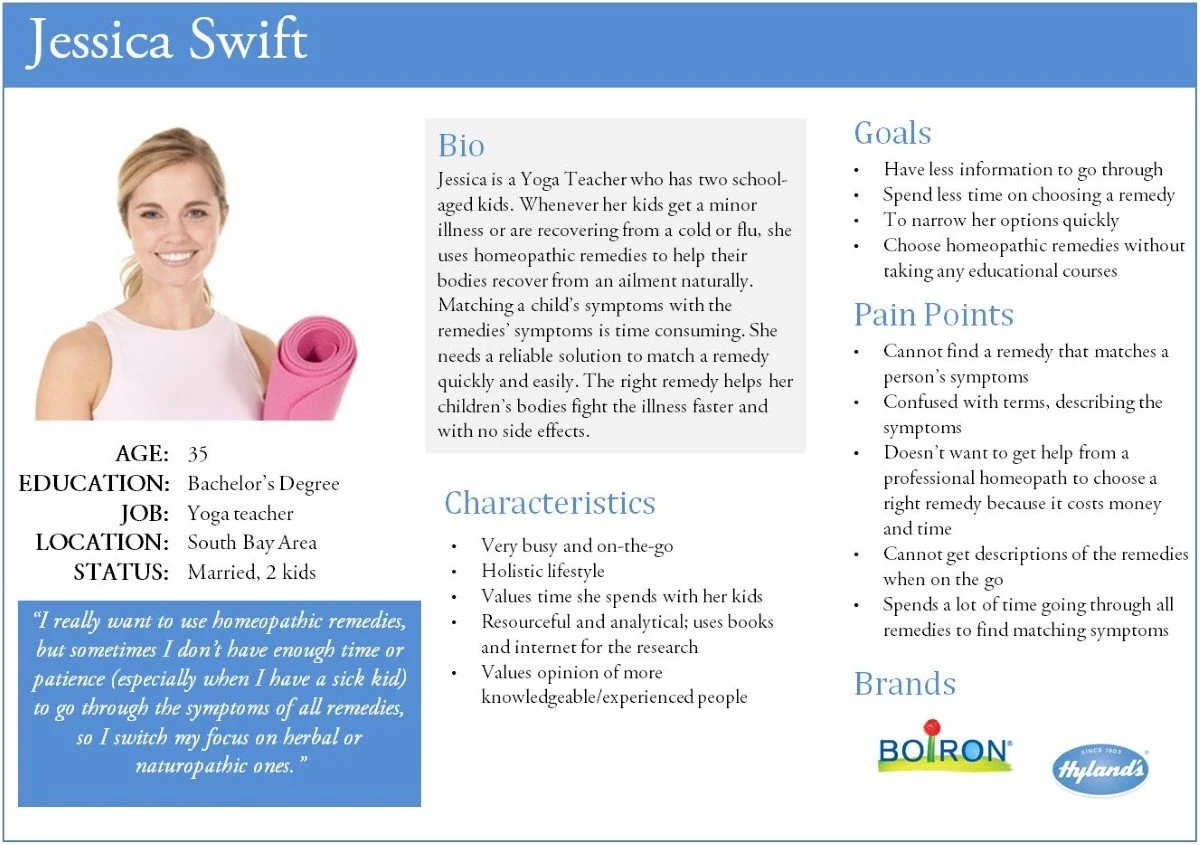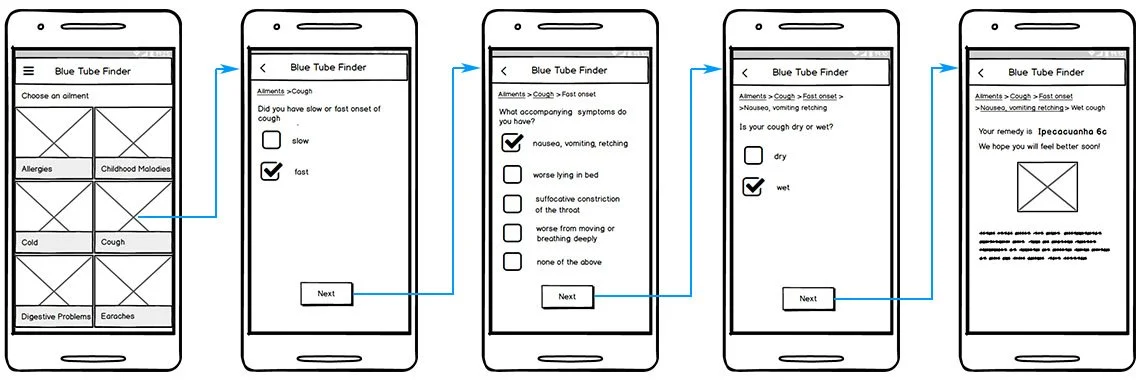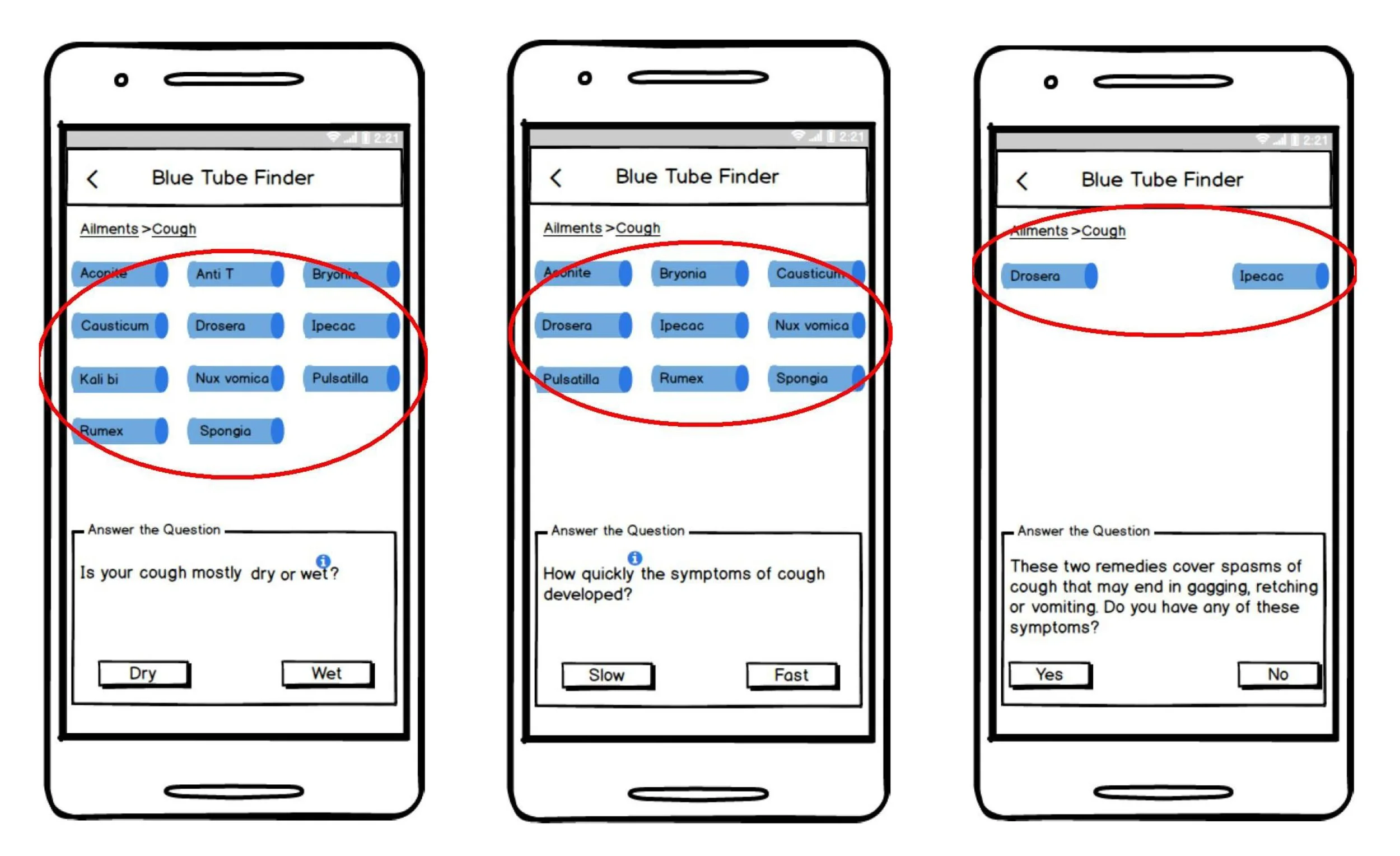
Blue Tube Finder
UX Research, Ideation, Prototyping, User Testing
Time
March
-
June 2017
Team
I worked solo
My Contribution
Comparative Analysis, UX Research, Ideation, Prototyping, User Testing
Case Study Overview
Homeopathy is a 200-year old medical system that people can use at home to help treat a sick person with a wide spectrum of acute health problems. To choose the right remedy, you need to match the set of the symptoms a sick person has to the certain symptoms a homeopathic remedy can relieve for a particular illness. To treat a chronic condition, you need to see a professional homeopath since the process of matching is more complicated and some remedies can be bought at homeopathic pharmacies by prescription only. Although, for an acute illness (like headache, cough, or cold) you can match a remedy yourself and buy it at any whole food store or online.
Problem
My client, a professional homeopath at Bay Homeopathy, who treats chronic conditions, always wanted to help her clients to use homeopathic remedies at home for acute conditions like cold, fever, headaches, etc. It didn't seem possible because she:
-

Could not help clients with acute illnesses because of her busy schedule.
-

Tried to educate her patients by conducting group studies, but only a few patients signed up.
-

Wrote several articles on her website, but only a few people read them.
As a result, my client needed a way to encourage her patients to match a homeopathic remedy without professional help.
Why Patients do not Match Homeopathic Remedies on Their Own?
To choose the right remedy, a patient needs to match the set of her/his symptoms to the certain symptoms a homeopathic remedy can relieve for a particular illness. Choosing the right remedy is not a simple task due to:
Challenge
My client needed a way to help her patients independently find homeopathic remedies for acute conditions.
Solution
UX research showed that there was a need for a digital product that could help a homeopathic practitioner and her patients find the right homeopathic remedy quickly, on a go, and without a homeopathic practitioner's help. The solution was to design a mobile application Blue Tube Finder. The app would provide the user with a list of homeopathic remedies for a particular illness, provide descriptions of each remedy, and help to match the patient’s symptoms with the ones that a remedy relieves.
Solution Preview
Process
During this project I completed the following activities:
Research
Domain Research and Understanding the Task
First, I started to learn more about homeopathy by reading articles on the web and homeopathic writings. I’ve learned how homeopathic remedies work, what is the difference between the principles on how conventional drugs and homeopathic remedies work, and whether both conventional medicines and homeopathic remedies can be taken at the same time. The most important topics I had to explore were how is a body’s immune system stimulated by a homeopathic remedy, how do symptoms help in finding a homeopathic remedy, and how to find the correct remedy for an acute illness.
Stakeholder and User Interviews
After exploring the topic, I moved to creating a research plan to determine research questions and research methods that would help to answer them.
According to my client, the current user base is mostly comprised of females in their 30s to mid-50s and local to the South Bay Area.
I conducted interviews with people who were currently using or had used homeopathic remedies for acute conditions. During my research, I interviewed a professional homeopath, people who work at vitamin and supplement departments at local natural food stores, a stay-at-home mom, who participated in a group study about how to use homeopathic remedies for acute conditions, a music teacher who occasionally uses homeopathic remedies and a QA Engineer, who had used homeopathic remedies in the past. I also talked to shoppers in a vitamin and supplement department at natural food stores.
Key Takeaways From the User Research
My research showed that target users are mostly females who:
-

live a healthy lifestyle
-

Prefer to use natural ways for treating acute ailments.
User research revealed three major steps that users take to find the right homeopathic remedy.
Read remedies’ description
Find information about homeopathic remedies from reliable sources.
2. Choose a remedy that matches most of the person’s symptoms
Establish what symptoms are clear and most pronounced, and write them down.
3. Buy the remedy
Go to the nearest store which sells homeopathic remedies or buy online.
I used these steps later during the Ideation Phase of the project to brainstorm the solutions.
The goals of the users who use homeopathic remedies are:
The pain points the users experience while looking for the right remedy are:
Competitive Analysis
While performing my competitive analysis, I was looking for how the competitors implemented their ‘Find the remedy’ feature. I found that there were few websites and only one mobile app which allowed users to find a homeopathic remedy. The competitor’s app was helpful for first-time users and people who do not mind taking combination homeopathic remedies. It wasn’t really valuable for people who were looking for a single homeopathic remedy.
Define
After summarizing my research findings, I changed my initial problem statement to the following:
Problem Definition
To help people, who use natural ways to ease their symptoms while having an acute illness, by creating a solution that provides them with information on homeopathic remedies for this illness and helps them find the right homeopathic remedy for it quickly, easily, without confusion, and without the help of a professional homeopath.
Problem Solution
The proposed solution was to create a mobile app that will:
Help find the right remedy for a condition.
Be easy to use, since the user’s emotional state is suppressed by illness or responsibility to find a remedy for a loved one who is sick.
Reduce time in the process of finding the right remedy.
Be straightforward and do not use specific or confusing language and terms.
Provide a combination remedy for an acute illness if a matching remedy is not found by the app.
The goal of this project was to test if the proposed solution would work for my client’s patients when they choose the remedies independently, so I decided to create a clickable prototype of an MVP and get feedback from the potential users.
Constraints
The proposed solution was to create a mobile app that will:
Experience: Mobile App
Users: People who are new to homeopathy and already use homeopathic remedies
Scope: Create an MVP with all features for one ailment (cough)
Design Style: Material Design
Scalability: Design a solution that can be scalable for the rest of the included in the app ailments
Creating Persona
I created a persona, whom I kept in mind while designing and brainstorming ideas for the solution.
Ideation
User Journey
To understand the user's pain points and see touchpoints between the user and solution, I created Jessica's experience on the Emotional Journey Map below, when she is having a cough and trying to find a homeopathic remedy.
User Flow
First, I analyzed the process of finding the right homeopathic remedy each interviewee experienced and created the current user flows. After plotting out the prevailing mental model for a remedy matching, I established a scenario and user flow for my solution.
Sketching
After I brainstormed ideas about how the process of choosing the right remedy would be implemented, I decided to introduce this feature in a form of answering questions, a process similar to a doctor-patient conversation in a doctor's office. While doing this, I took into consideration the first two steps in the process of finding the right homeopathic remedy and kept in mind the user's goals. The questionnaire was designed in a way that didn't leave a user without a remedy.
Prototype and Test
All my prototypes in Rounds I, II, and III were created using Balsamiq. To test them with users, I exported the prototypes to clickable pdf files.
For each usability study, I recruited participants who were my client’s patients, wrote scenarios, facilitated and videoed the sessions, and analyzed the findings.
Round I
I implemented my initial design and created my first prototype which I tested with four users. The main finding at this round was that my first design didn’t show the users the progression of the process of choosing the right remedy.
Brainstorming Ideas about Representing the User’s Progression
The decision tree had many branches with different path lengths. The number of questions depended on answers to previous questions.
Challenge
The challenge was to show a user how far she has progressed in the process of answering questions in order to get to the right remedy.
Solution
Instead of showing a user the number of questions she needed to answer, I decided to show the remedies for each ailment. I placed small images of all remedies for chosen ailment on the initial screen and eliminated the remedies from the next screen depending on the user's answers.
Round II
During the second round of testing with five users, two usability issues were found. First, some users were confused about how to answer questions if they weren’t sure about the question, so added a new ‘Not Sure’ button. Secondly, some users didn’t know what some terms meant in some questions. To resolve this issue, a definitions feature was added.
Round III
This time, I tested my prototype with three users. After each user smoothly went through all questions and found a remedy, some of them felt that they needed a way to either save the name of the remedy somewhere (or share it) or find more information about it online (or even buy it).
Taking into consideration these findings and the goals of my client (my client's goal was not to sell remedies online), I redesigned the remedy screen accordingly.
In total, I conducted 12 usability tests. The final version of the clickable prototype that was used during the last user testing is a strong foundation for developing an MVP.
To present the final version to the client, I created a prototype in Sketch and using Flinto created a video to show the app in action.
Lessons Learned
Although I had experience with homeopathic remedies before, I needed to learn and research about the prosses of matching the set of the symptoms a sick person has to the certain symptoms a homeopathic remedy can help relieve for a particular illness. It was interesting to know that a remedy is not chosen only by the ailment it can ease. It is very important to learn about the person's chief complaint, minor complaints, and various other physical and psychological symptoms in order to choose the right homeopathic remedy. Unlike the "one size fits all" approach to prescribing often used in conventional medicine, a homeopathic remedy matches the unique symptom profile of an individual.
During this project, I also learned that the steps users take while performing a task cannot be omitted during the design of a digital solution for it, even if it doesn't align with the client's business goals. I am glad that I caught it during usability testing. After using the Blue Tube Finder app to find a remedy for his illness, one of the participants asked me: "I don't see how and where I can buy this remedy in your app." I replied to him that the purpose of this app is not to sell the remedies but to help a user to find the right one. It immediately came to my attention that even though selling the remedies wasn't my client's business goal, I couldn't ignore that final step. I addressed it accordingly by redesigning the remedy's screen and giving a user an opportunity either to save/share a remedy or go online and find more information about it.




























